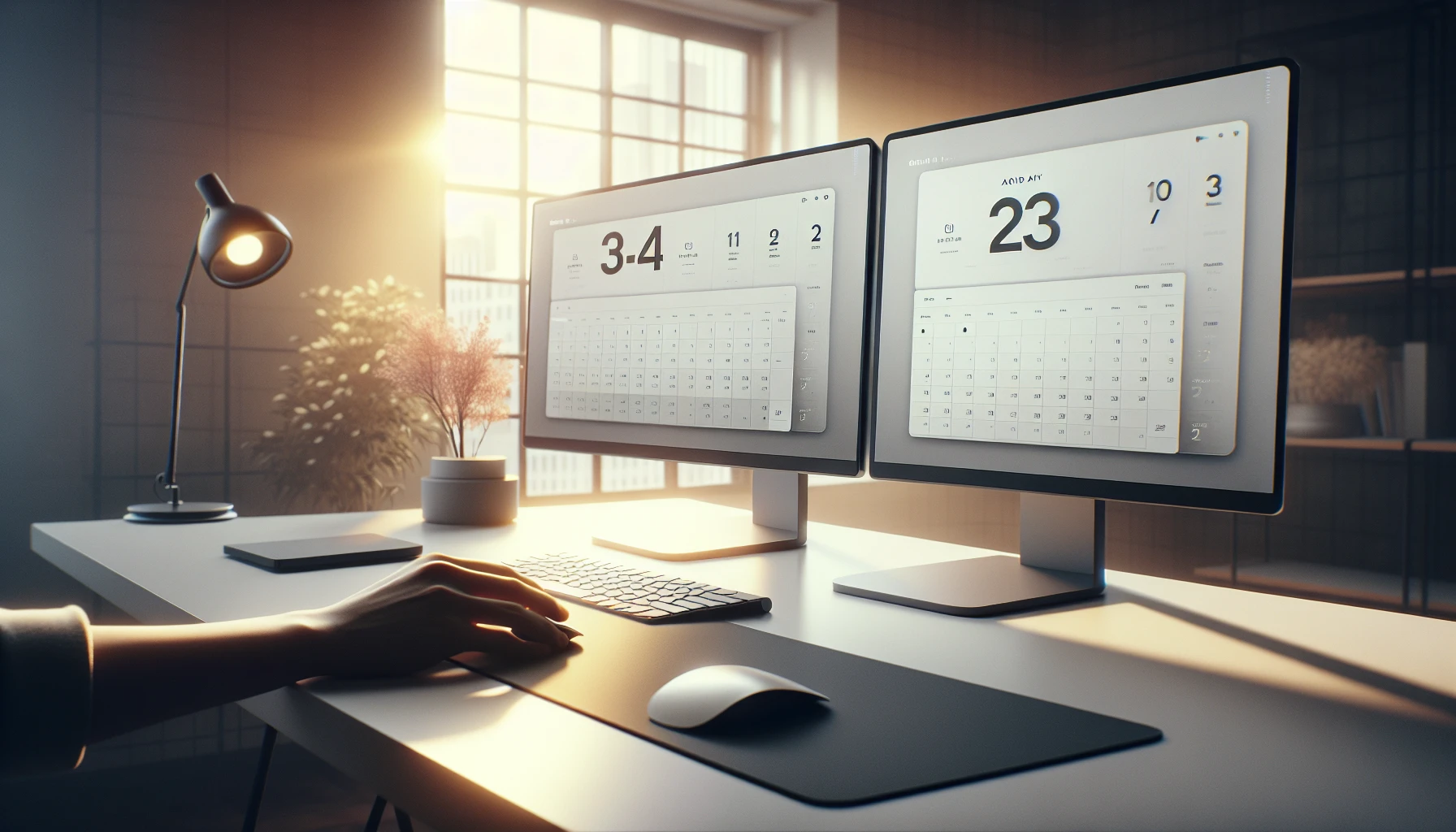· Ricardo Batista · 13 min read
Crafting Effective Meeting Reminder Emails
Learn how to write compelling meeting reminder emails with our guide.

In the quick-moving realm of commerce, clear interaction is vital. Meeting alert messages play a key function in guaranteeing crucial appointments aren’t overlooked. Prompt & understandable communication can make a major impact on meetings’ triumph. This piece will guide you on composing persuasive meeting reminder emails that boost productivity & streamline your scheduling procedure.
Key Takeaways
- Crafting effective meeting reminder emails is essential for ensuring smooth and productive gatherings.
- Employing resources like Gathering Alerts can mechanize the notification procedure, conserving time & guaranteeing timely reminders.
- Examining reactions & tweaking plans based on replies could assist in enhancing the usefulness of gathering alerts.
- Customizing notification messages & being straightforward, brief, and friendly are crucial to boosting participant involvement.
Introduction to Meeting Reminder Emails
Importance of Timely and Clear Communication
In the quick-moving biz world, good communication is key. Timely & clear talking makes sure everyone’s on the same page, cutting misunderstandings & boosting productivity. Meeting reminder emails play a big part in this talking plan by making sure all attendees know the meeting details way ahead of time. These reminders help manage time well, making sure meetings start & end on schedule, which is essential for keeping a smooth workflow going.
Overview of Benefits of Using Meeting Reminders
Notifications for gatherings aren’t just about informing participants; they provide various concrete advantages that could boost the productivity of any company. Initially, they assist in decreasing the no-appearance rate substantially. Through delivering timely alerts, attendees are less probable to disregard or overlook their obligations. Secondly, these notifications could additionally function as a method for supplying pre-meeting resources, guaranteeing that all participants are equipped with the appropriate papers or data beforehand, which results in more fruitful sessions.
Furthermore, utilizing a specialized instrument like Meeting Reminders can mechanize the procedure of conveying these notices. This assistance not just sends out updates however additionally pings participants who haven’t appeared, saving significant time that would somehow or another be spent physically reminding every member. For those hoping to execute viable suggestion frameworks, investigating layouts like those found in the Meeting Reminder Email Template can give a speedy beginning. These layouts are intended to be clear & proficient, guaranteeing that the message is passed on viably.
In conclusion, combining meeting reminder emails into your communication plan is not just about reminding someone of a gathering; it’s about improving the overall communication flow within your company. By utilizing tools like Meeting Reminders, businesses can guarantee higher attendance rates, better preparation, & ultimately, more productive meetings.
Essential Elements of a Meeting Reminder Email
When making a meeting reminder email, it’s key to balance clearness & courtesy to guarantee max attendance & timeliness. The service Meeting Reminders is great at automating this process, ensuring that participants are quickly reminded of upcoming gatherings, particularly if they aren’t arriving on schedule.
Key Information to Include
A well-structured meeting reminder email should contain several key pieces of information to ensure it is effective:
- Subject Line: This ought to be straightforward & succinct. For instance, “Reminder: Marketing Plan Gathering at 3 PM Tomorrow”.
- Gathering Date & Time: Evidently express the date & time of the get-together. Contemplate referencing the time region if attendees are dispersed across diverse zones.
- Gathering Plan: Give a quick summary of the meeting’s schedule. This assists attendees get ready & comprehend why their presence is crucial.
- Location or Link to the Meeting: Specify the physical location or provide the link to the virtual meeting room.
- RSVP or Confirmation Request: Ask participants to confirm their attendance if required.
- Get in Touch Details: Put down ways to reach somebody who could be contacted for any last-second queries or explanations.
For templates & more detailed examples, you can refer to the Meeting Reminder Email Template which offers ready-to-use formats to simplify your communication.
Tone and Language Tips
The tone & language of your meeting reminder email should be professional yet approachable. Here are some tips to ensure your message is well-received.
- Stay Brief & Straightforward: Maintain the message short and direct. Evade extraneous specifics that could muddle the key info.
- Use Polite Language: Phrases like “please” and “thank you” make the email sound courteous and respectful.
- Make It Personal When You Can: Calling the person by their name & mentioning any special things they’re supposed to do can get them more involved.
- Significance & Necessity: Without being too dramatic, express the significance of the gathering & any preparations needed beforehand.
Combining these factors, your gathering notification messages won’t just remind but additionally motivate & help most extreme cooperation. For extra bits of knowledge on making viable updates, think about investigating the Instructions to Send a Meeting Reminder in Outlook guide, which gives extra pointers customized for Outlook clients.
Step-by-Step Guide to Writing a Meeting Reminder
Writing an efficient meeting alert is vital to guarantee full participation & readiness from all attendees. Utilizing a platform like Meeting Reminders can greatly simplify this procedure by automatically informing latecomers, thus saving you the effort & trouble of manual follow-ups.
Choosing the Right Timing
The timing of your gathering alert can significantly impact its usefulness. Preferably, transmit an initial notification seven days beforehand, followed by a more pressing reminder the day prior to the assembly. This approach assists in accommodating diverse planning methods & keeps the meeting at the forefront for all participants. For those inclined to schedule their weeks ahead, the week-earlier alert will prove vital, while the day-before reminder serves as a timely prod for others.
Structuring Your Email
A well-organized reminder email ought to be succinct yet enlightening sufficient to captivate the recipients. Commence with an evident subject line, like “Reminder: [Meeting Title] on [Date & Time].” Utilize a courteous & professional demeanor all through the message! Evidently express the meeting’s intent, the anticipated duration, and any preparation necessitated from the attendees. Incorporate a concise agenda if feasible to provide a glimpse of the meeting’s arrangement. For templates & more thorough guidance, contemplate visiting the Meeting Reminder Email Template blog post.
Personalization Techniques
Customizing your gathering alerts could boost the probability of participation & involvement. Greet attendees by their first name & if the group dimension permits, incorporate personalized remarks or queries that might connect to their contributions. For example, “Eagerly awaiting your perspectives on our forthcoming endeavor, [Name]!” Moreover, utilities like Meeting Reminders enable you to streamline personalization at scale, guaranteeing that every participant gets a tailored reminder effortlessly.
By adhering to these guidelines & leveraging resources like Appointment Alerts, you can boost the productivity & efficacy of your conference coordination procedures, facilitating smoother & more fruitful assemblies.
Leveraging Technology: Tools and Integrations
In this day & age’s fast-moving work setting, utilizing tech to simplify procedures is crucial. Instruments & combinations that mechanize chores can substantially boost productivity, guaranteeing that workflows are more seamless & fruitful.
Using AI and Automation for Efficiency
Artificial Intelligence (AI) & automation are at the forefront of transforming business operations. These technologies can automate routine tasks, reduce errors, and free up valuable time for strategic activities. For example, AI can be utilized to schedule meetings, manage emails, & even remind participants of upcoming appointments.
A realistic usage of AI in controlling gatherings is via facilities like Meeting Reminders. This utility mechanically informs meeting participants who aren’t there at the planned beginning time! It gets rid of the requirement to physically follow participant attendance & send notifications, thereby saving time & decreasing the administrative load.
Popular Tools and How to Use Them
Here’s the modified version of the content, following the instructions provided:
Zoom: Frequently utilized for online gatherings, Zoom permits you to arrange meetings & integrate them with calendars. Participants can establish automated notifications that remind attendees prior to the meeting’s commencement.
Google Calendar: This tool could be combined with different meeting platforms. People are able to make events, invite participants, & enable automatic reminders. Google Calendar could be synced with Meeting Reminders to further improve its functionality.
Slack: Recognized for its quick messaging abilities, Slack additionally provides tools to arrange gatherings & set alerts inside channels. Combining Slack with Meeting Reminders could guarantee that every participant gets timely notifications regarding forthcoming meetings.
For thorough instructions on establishing reminders in Outlook, you could discover the blog entry on how to transmit a gathering reminder in Outlook especially advantageous. This combination guarantees that no attendee overlooks crucial gatherings because of carelessness or miscommunication.
By combining these instruments alongside AI-powered amenities like Gathering Alerts, companies could substantially boost their functional productivity & communication efficacy.
Templates and Examples
Meeting alerts are key for making sure everyone shows up on time, helping planned get-togethers go smoothly. Using pre-made templates can really simplify sending these notifications. Here, we look at various free options & how to tweak them for different situations.
20 Free Templates from Leadmonk
Leadmonk provides 20 complimentary layouts which appeal to a diverse assortment of gatherings—from official corporate conferences to relaxed squad check-ins. These blueprints are fashioned to be promptly usable & can be effortlessly incorporated into different communication channels. To utilize these templates successfully, adhere to these straightforward instructions:
- Choose a Template: Select a template that best fits the nature of your meeting.
- Customize the Content: Modify the time, date, and location details according to your meeting specifics.
- Incorporate Personal Touches: Add personal notes or instructions specific to the meeting or participants.
- Send Out the Reminder: Use your preferred email or messaging service to dispatch the reminder to all attendees.
Customizing Templates for Different Scenarios
Modifying layouts entails more than simply completing the gaps with gathering specifics; it necessitates adjusting the communication to suit the setting & culture of the gathering and its attendees. Here’s how you can personalize layouts for diverse situations:
- Formal Gatherings: Utilize a courteous & expert manner, guarantee all logistical specifics are evident, & maybe incorporate a proper welcome or farewell.
- Casual Team Get-Togethers: Embrace a more laid-back vibe, utilize first names, & perhaps incorporate some fun-loving components or emojis if fitting.
- Client Meetings: Provide a quick summary of the schedule, show gratitude for the customer’s time, and verify the meeting goals & expectations.
Meeting Reminders, a feature accessible at Meeting Reminders, improves this procedure by instantly informing participants who haven’t arrived for the gathering. This utility is particularly handy for occupied experts who can’t spare the time to personally pursue late attendees. By incorporating Meeting Reminders into your routine, you can guarantee higher turnout and more productive meetings.
For more in-depth advice on making compelling meeting notifications, you could check out additional sources like the Meeting Reminder Email Template blog entry, which offers concrete illustrations & further customization suggestions.
Best Practices and Common Mistakes
Do’s and Don’ts in Reminder Emails
When making reminder emails, it’s key to find a middle ground between being informative & brief. Here are some important do’s & don’ts:
Do:
- Be Straightforward & Succinct: Begin with a plain topic line like “Reminder: Upcoming Gathering on [Date/Time].” Maintain the communication short and to the point.
- Incorporate Vital Specifics: Guarantee the message incorporates every crucial detail, like the gathering date, hour, & platform connection. Resources such as Meeting Reminders can mechanize this procedure, confirming all participants get opportune & precise data.
- Utilize a Cordial Manner: A courteous & amiable style can boost the impact of your communication. Contemplate expressions such as “Eagerly awaiting your presence!” or “Your input is highly valued!”
Don’t:
- Overly-Communicate: Transmitting an excessive number of reminders could potentially be counterproductive. Restrict reminders to a maximum of two: one a week prior and another a day preceding the event.
- Be Vague: Avoid vague language that might confuse the recipient. Be specific about the action required.
- Don’t Forget to Make it Personal: Whenever you can, customize the email. Basic changes, like putting the person’s name, can boost involvement.
For more detailed examples, check out this Meeting Reminder Email Template.
Analyzing Feedback and Adjusting Strategies
To enhance the impact of your meeting alerts, it’s crucial to examine responses & modify your tactics as needed:
- Obtain Opinions: Subsequent to the gathering, transmit a concise follow-up electronic message requesting input on the meeting & the reminders acquired. This could be as straightforward as a couple of inquiries or a connection to a poll.
- Assess Reactions: Search for widespread ideas or proposals in the input. Are participants discovering the prompts advantageous? Are they obtaining the data they require?
- Modify Suitably: Contingent upon the input, execute essential alterations. This could entail altering the timing of your prompts, the data incorporated, or perhaps the platform utilized for transmitting them.
By constantly enhancing your technique, you’re able to guarantee that your gathering alerts are as compelling as could be expected. Instruments like Meeting Reminders provide analytical capabilities that can assist you with following and breaking down participant reactions, making it simpler to customize your methodology.
For further insights into setting up effective reminders in Outlook, consider reading about how to send a meeting reminder in Outlook.
Conclusion
In conclusion, dominating the skill of creating compelling meeting notification emails is crucial for guaranteeing seamless & fruitful assemblies. By adhering to recommended practices like being straightforward, succinct, yet amiable in your correspondence, you can boost attendee involvement & participation. Utilizing tools such as Meeting Reminders can streamline the reminder procedure, saving you effort & ensuring all participants receive timely notifications. Recollect to scrutinize feedback & adjust your tactics accordingly to continually enhance the efficacy of your reminders. With the appropriate strategy & tools at your disposal, you can simplify your meeting management process & improve overall communication within your organization! Remain proactive, remain organized, & observe your meetings become more efficient & triumphant.
Frequently Asked Questions (FAQs)
How can meeting reminder emails improve meeting attendance?
Meeting reminder emails are vital in boosting meeting participation by guaranteeing that attendees are notified & reminded of forthcoming gatherings ahead of time. By utilizing tools like Meeting Reminders, you can streamline this procedure & heighten the probability of participants arriving punctually.
What are the key elements to include in a meeting reminder email?
Key elements to include in a meeting reminder email are the meeting date, time, location or link, agenda, RSVP request, & contact information. These specifics assist guarantee that participants possess all the required info to attend the meeting ready & on schedule.
How can I personalize meeting reminder emails for better engagement?
Customizing gathering prompt messages by calling receivers by title, containing particular subtleties connected with their commitments or advantages, & utilizing an agreeable tone can upgrade commitment. Instruments like Meeting Pointers proposition highlights to robotize personalization at scale.
What are some common mistakes to avoid when sending meeting reminder emails?
Frequent blunders to dodge when transmitting gathering prompt messages incorporate over-conveying by sending an excessive number of updates, being ambiguous in the message substance, & overlooking to customize the messages. It’s critical to strike an equilibrium between being useful & conscious of beneficiaries’ time.
How can I analyze feedback on meeting reminders to improve future strategies?
To examine comments on gathering alerts, you could dispatch follow-up messages requesting input, assess replies for normal subjects or proposals, & modify your reminder techniques appropriately. Instruments like Meeting Reminders give examination highlights to follow participant reactions & assist with customizing your methodology for improved outcomes.



